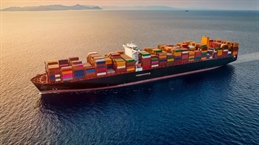
Container shipping demand on the Transpacific route has sharply declined following an early summer surge as tariff deadlines and uncertainty loom, according to the DHL Ocean Freight Market Update Report for July.
It noted that spot freight rates, which saw a 1.5-fold increase in June, have since plummeted as shippers withhold shipments ahead of new tariff deadlines in July and August.
"Tariff uncertainty has turned Transpacific container shipping demand into the faulty tap of global trade – hot one moment, freezing the next," the report said.
Carriers are also slashing Transpacific shipping capacity by over 20% to stem the decline, but oversupply risks persist.
"Carriers rushed to add capacity on the Transpacific to chase early gains, but oversupply is becoming apparent as the momentum fades," Niki Frank, CEO, DHL Global Forwarding Asia Pacific, said.
DHL noted that a wave of blank sailings, coupled with niche carriers moving operations into better-performing markets, is also likely to happen.
It said that with shippers holding back shipments while awaiting tariff policy clarity, carriers have been hurriedly putting in motion plans to cut shipping capacity on the route by over 20% to stem the decline.
However, there was "little sign of the strategy proving successful" in the second week of July.
Frank noted that with this, DHL is ready to adapt swiftly to an ever-changing situation, seeking an optimal balance between demand and capacity for customers.
Impact on schedule reliability
DHL Ocean Freight Market Update Report said ports are also experiencing worsening congestion, with 36% of North Asia's capacity affected.
Empty container returns have surged by 40.9% since pre-pandemic levels, raising costs and shortage risks.
Additionally, while carrier schedule reliability improved to 65.8% in May, shippers are facing worsening cargo delays.
DHL said a gap between reported reliability and actual TEU-based performance has widened since early 2025, with delays averaging 0.2 days longer than measured.
"Observers have highlighted positive signs that trade is finding more receptive paths and increasingly bypassing the U.S. market."
Meanwhile, the report noted that China's exports to the U.S. declined by 9.7% this year, while shipments to the UK, ASEAN, and Africa grew by 7.4%, 12.2%, and 18.9%, respectively.
Asia-Europe rates have also overtaken Transpacific prices for the first time in 2025.
According to Lars Jensen, CEO, Vespucci Maritime, cargo loaded in May has shown that global demand grew 1.8%. "That doesn't sound like much, but where it becomes real interesting is if I take all cargo in all the world, except for North America, global demand grew 5.6% which is nice, decent, solid growth, and in line with what we have seen for quite a while," Jensen said.
Praveen Gregory, senior vice president, Ocean Freight, DHL Global Forwarding Asia Pacific, noted that the data show a clear split in global trade patterns. "While U.S. routes remain volatile and policy-driven, other corridors are showing healthy growth."
Nonetheless, DHL noted that the growth in Asia-Europe trade also comes with added challenges for ports experiencing the knock-on effect of the June shipment surge.
Citing July 12 data from Linerlytica, DHL said there is "no improvement" in North Europe, with waiting times rising as high as seven days in Rotterdam and Antwerp.
Congestions at major North American ports, especially at Los Angeles and Long Beach, are seeing 4% of capacity tied up. In Asia, congestion is rising, particularly in North Asia, where 36% of capacity is affected.
"Among this scene is another developing situation, where the number of returning empty containers has risen 40.9% since the pre-pandemic period, while full container shipments have increased only 9.7%," DHL Ocean Freight Market Update Report for July said.
It noted that this "imbalance" raises costs and creates operational challenges, thereby increasing the risk of temporary equipment shortages.



